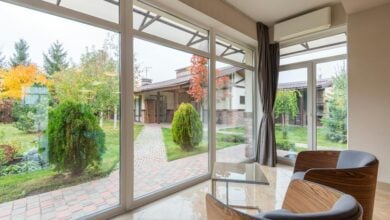The minimalist look is popular. People in modern homes are choosing to move on from traditional décor to designs that are simple, chic, and minimal. Even older properties benefit from simplification, but that’s not all that a minimalist home is about.
Minimalism is as much about practicality as it is trendy design and beautiful looks. It’s about getting the right mix between having what you need and not being overwhelmed with details. There’s a lot of thought that goes into something that, ultimately, looks easy when finished. What is easy is to get the minimalist look wrong.
We’ve put together some key aspects of designing a minimalist home that we hope will help you find the right balance, so let’s start with one of the most important factors, the general décor itself.
Neutral Colours
The first step in creating your minimalist home is to start with a clean sheet of paper. Ignore what’s there now, and imagine you are working with a bare shell. Next, you need to think about the colour of the walls and woodwork in each room. The general idea is to design a clean and fresh look that is uncluttered and neat. This naturally removes patterned wallpaper, for example, from the equation.
That’s not to say you can’t add pattern as an accent – more on that later – but that overall, you want a plain finish to those walls. Let’s say you’re creating a minimalist living room. Choose a classic magnolia, with white doors and window frames. Or a pale blue or green that will give you a nice background to work with. You can add accents later, but for now, concentrate on deciding on your colour schemes for each room.
Furniture is the Key
The minimalist home is about function and beauty. Furniture is central to the theme in every room., There are some excellent minimalist furniture brands that take their inspiration from mid-century modern and bring it up to date. Using clean lines, unusual materials such as metals and plastics, or more traditional upholstered finishes you can find some simply gorgeous furniture around which to create your room.
Using that living room example, think of a sofa that is central rather than pushed out the way. This will work only in larger rooms but can be very effective. Or you may want to use furniture that is modular and can be arranged in several ways. Look for clean and simple designs in muted colours that complement your chosen décor, and whatever you do forget about superfluous items such as occasional tables which take up space and add nothing.
Hidden Storage Solutions
One of the greatest achievements of 20th century design was that of creating storage solutions that could be hidden away. You need storage even in your minimalist home, and hidden storage is an excellent idea. You can buy cupboards that, when closed, you would not know are there. The same applies to kitchen appliances which can be brought into sight only when needed, and closets in bedrooms.
This sort of beautiful and yet practical design is a bonus for the minimalist home and is also a space-saving option. There’s a lot of choices when it comes to hidden storage solutions, and we suggest looking for those that serve a double purpose – such as beds with storage underneath which are great for smaller homes – and design your rooms around the storage, rather than waiting to see what space you have left.
Fewer Surfaces Mean Less Clutter
Earlier we mentioned a lack of occasional furniture. Think about it: if there is a surface available, things will get put on it rather than being taken back to where they belong. Surfaces encourage clutter, and clutter is the enemy of the minimalist home. Clutter is ugly and tiresome, so try and keep surfaces to a minimum in every room. It might be time to consider investing in a Brighton storage facility that could help you store unwanted home decorations while at the same time, maintain the minimalist vibe of your home.
In the living room, for example, tables should be entirely absent. There is no need for them, and they just gather clutter and dust. You may want shelves to display a collection. Why not design a display cabinet – or buy one from your local furniture store – that is simple and enclosed and will fit with your décor and style? There’s plenty of choices, and this removes the added potential surfaces that shelves provide. You’ll see what we mean if you look at some interior design blogs with a modern theme.
Keep It Simple, Stupid!
The ‘KISS Principle’ – Keep it Simple Stupid – was bizarrely developed by an aircraft engineer working for the US Navy in the 1960s! The principle is that systems work more efficiently if they are kept simple. It quickly made its way into the design of all types, and in different forms is part of the minimalist look and ideal. KISS is about avoiding unnecessary complexity. That’s why it should be at the core of your minimalist home design.
With no added complications and the KISS principle applied when designing your minimalist home, you should find that everything is both practical and beautiful, and that clutter is nowhere to be seen. This is the key to getting the minimalist look right, rather than ending up with a design that is simply bland. That brings us neatly to our final point.
Accent with Care
Nobody will enjoy spending time in a plain beige room, for example, so you will wish to add some adornment at least. Adding an accent in the form of a picture, perhaps, is a great idea to break up the monotony. However, it needs to be chosen with care. We suggest that an abstract strong colour, not too small, be placed on the main feature wall as a focal point. This will give the room some added strength without taking away from the minimalist appeal.
A minimalist home is not just attractive and stylish, it also requires far less maintenance, so start thinking about where you can begin your changes and check out minimalist furniture designs now.




